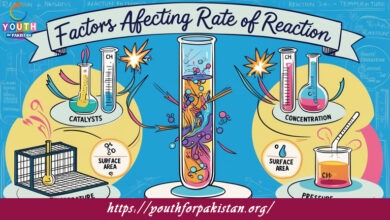Energetic Of Bond Formation MDCAT MCQs with Answers

Welcome to the Energetic Of Bond Formation MDCAT MCQs with Answers. In this post, we have shared Energetic Of Bond Formation Multiple Choice Questions and Answers for PMC MDCAT 2024. Each question in MDCAT Chemistry offers a chance to enhance your knowledge regarding Energetic Of Bond Formation MCQs in this MDCAT Online Test.
The energy required to break one mole of a bond in a molecule is known as:
a) Bond dissociation energy
b) Bond formation energy
c) Ionization energy
d) Electron affinity
When a bond is formed between two atoms, the process is typically:
a) Endothermic
b) Exothermic
c) Isothermal
d) Adiabatic
The bond dissociation energy of a molecule is generally:
a) Higher for multiple bonds than for single bonds
b) Lower for multiple bonds than for single bonds
c) The same for multiple and single bonds
d) Unpredictable
In the context of bond formation, an exothermic reaction:
a) Releases energy
b) Absorbs energy
c) Does not involve energy change
d) Requires a catalyst
The enthalpy change associated with the formation of one mole of a compound from its elements in their standard states is called:
a) Standard enthalpy of formation
b) Bond dissociation energy
c) Standard enthalpy of reaction
d) Bond energy
Which of the following bonds requires the highest amount of energy to break?
a) Single bond
b) Double bond
c) Triple bond
d) Quadruple bond
The energy change during the formation of a bond is:
a) Equal to the bond dissociation energy
b) Opposite in sign to the bond dissociation energy
c) Half of the bond dissociation energy
d) Double the bond dissociation energy
In a chemical reaction, if bond formation releases energy, the reaction is classified as:
a) Endothermic
b) Exothermic
c) Isothermal
d) Isobaric
The process of breaking a bond in a molecule requires:
a) Energy input
b) Energy release
c) No energy change
d) A decrease in temperature
The standard enthalpy of formation for a molecule is measured under:
a) High pressure
b) Low temperature
c) Standard conditions
d) Variable conditions
Which of the following bonds is the weakest?
a) C-C single bond
b) C=C double bond
c) C≡C triple bond
d) C-H single bond
Bond dissociation energy is usually measured in units of:
a) Joules per mole
b) Kilojoules per mole
c) Calories per mole
d) Kilocalories per mole
The energy required to break all the bonds in one mole of a molecule in the gas phase is called:
a) Bond dissociation energy
b) Bond formation energy
c) Heat of reaction
d) Enthalpy of combustion
The enthalpy change of a reaction can be determined using:
a) Hess’s Law
b) Dalton’s Law
c) Raoult’s Law
d) Le Chatelier’s Principle
A bond that is difficult to break has:
a) Low bond dissociation energy
b) High bond dissociation energy
c) No bond dissociation energy
d) Variable bond dissociation energy
The energy released when a bond is formed is:
a) Equal to the energy required to break the bond
b) Less than the energy required to break the bond
c) Greater than the energy required to break the bond
d) Unrelated to the bond dissociation energy
The standard enthalpy of formation of a compound is zero for:
a) Pure elements in their standard states
b) Compounds in their standard states
c) Aqueous solutions
d) Gases at high temperatures
The strength of a bond can be estimated by:
a) The bond length
b) The bond dissociation energy
c) The molecular weight
d) The number of electron shells
The bond dissociation energy of H-H bond is:
a) Higher than O=O bond
b) Lower than O=O bond
c) Equal to O=O bond
d) Not measurable
The enthalpy change of a reaction can be calculated using:
a) Bond energies of the reactants and products
b) Atomic masses
c) Molecular formulas only
d) Reactivity series
In an exothermic reaction, the energy of the products is:
a) Higher than the energy of the reactants
b) Lower than the energy of the reactants
c) The same as the energy of the reactants
d) Unchanged
The process of bond formation:
a) Always absorbs energy
b) Always releases energy
c) Can either absorb or release energy
d) Is always isothermal
The enthalpy of reaction can be found using:
a) Heat capacities
b) Bond dissociation energies
c) Electronegativity values
d) Molecular weights
In a reaction where the bond formation is endothermic, the overall enthalpy change is:
a) Positive
b) Negative
c) Zero
d) Variable
Which type of bond generally has the highest bond dissociation energy?
a) Single bond
b) Double bond
c) Triple bond
d) Quadruple bond
Bond energies are typically:
a) Higher for larger atoms
b) Lower for larger atoms
c) Independent of atomic size
d) Dependent on bond type and environment
The bond dissociation energy of a molecule can be used to:
a) Predict the reaction rate
b) Calculate the equilibrium constant
c) Estimate the energy change of a reaction
d) Determine the acidity of the molecule
The enthalpy change for the formation of a compound from its elements is:
a) Always negative
b) Always positive
c) Zero if the compound is in its standard state
d) Variable
The energy needed to break a bond is a measure of:
a) Bond length
b) Bond strength
c) Bond angle
d) Bond order
The bond dissociation energy of a molecule is generally:
a) Higher in a liquid state than in a gas state
b) Lower in a liquid state than in a gas state
c) The same in both states
d) Not measurable in different states
In an endothermic reaction, the enthalpy change is:
a) Positive
b) Negative
c) Zero
d) Unpredictable
The energy required to break a bond in a molecule is related to:
a) The bond’s length
b) The bond’s angle
c) The bond’s dissociation energy
d) The bond’s order
Which bond in a molecule would generally have the highest dissociation energy?
a) C-H single bond
b) C-C single bond
c) C=O double bond
d) N≡N triple bond
The bond dissociation energy is:
a) Always positive
b) Always negative
c) Zero
d) Variable
In which of the following processes is energy absorbed?
a) Bond formation
b) Bond breaking
c) Condensation
d) Freezing
The energy required to break all the bonds in a mole of a substance is known as:
a) Enthalpy of vaporization
b) Bond dissociation energy
c) Heat of combustion
d) Heat of fusion
The bond strength of a molecule can be influenced by:
a) The type of atoms involved
b) The bond length
c) The bond angle
d) The molecular mass
The bond dissociation energy can be used to:
a) Determine the temperature of a substance
b) Predict the reaction rate
c) Calculate the amount of heat absorbed or released in a reaction
d) Measure the concentration of a solution
The enthalpy change for breaking a bond is equal to:
a) The bond formation energy
b) The bond dissociation energy
c) The bond energy in the gas phase
d) The heat of reaction
The bond dissociation energy of a molecule can be affected by:
a) The temperature
b) The pressure
c) The physical state of the molecule
d) All of the above
If you are interested to enhance your knowledge regarding Physics, Chemistry, Computer, and Biology please click on the link of each category, you will be redirected to dedicated website for each category.




